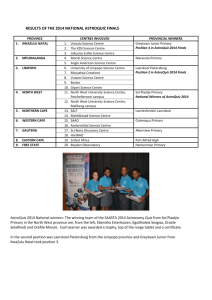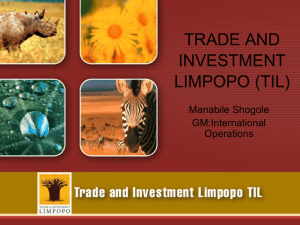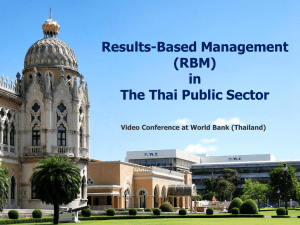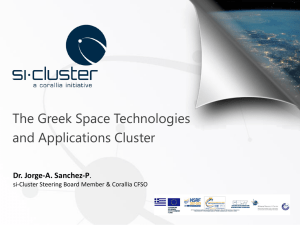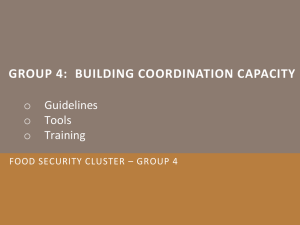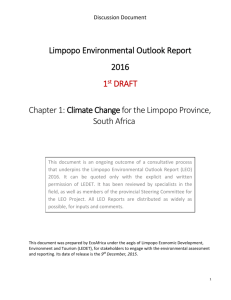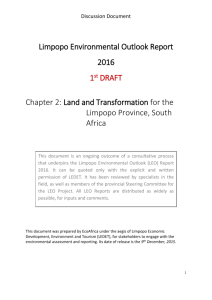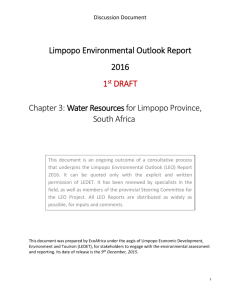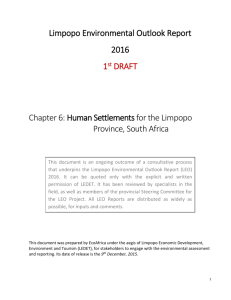Integrating Infrastructure in Limpopo
advertisement
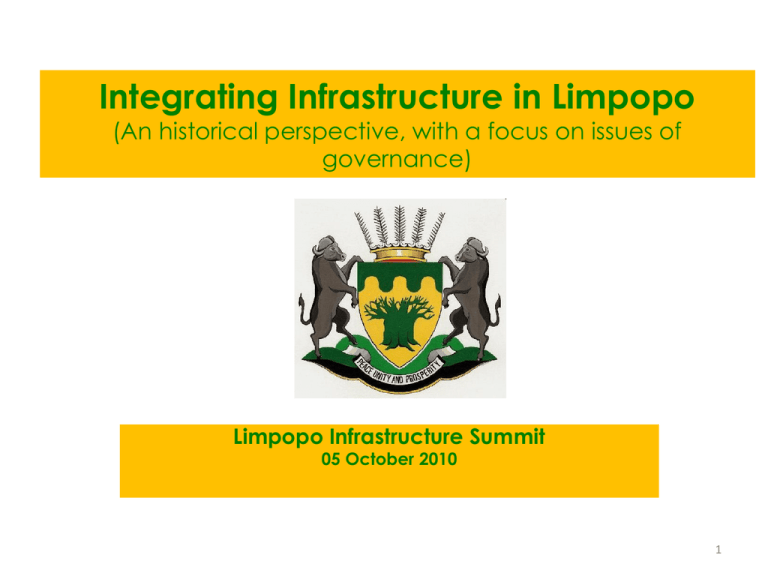
Integrating Infrastructure in Limpopo (An historical perspective, with a focus on issues of governance) Limpopo Infrastructure Summit 05 October 2010 1 Development is about people • The fundamental concept, underpinning both the earlier Provincial Growth and Development Strategy (PGDS) and our current Limpopo Employment Growth and Development Plan (LEGDP) is that ‘development is about people’ and not about things and structures Development is about people • The paradigm shift: from structures to relationships, from investing in knowledge as opposed to things, from continuity to discontinuity, underpinning not only organisational change but scientific thought itself, is a reality. - is worship about a church building? - is education about a school building? - is communication about a meeting or a forum? (The answer is NO - appropriate infrastructure Supports – it creates an enabling environment) Development is about people • The challenge of creating permanent infrastructure for a shifting environment - the impact of urbanisation and the quest for integrated rural development • There is need to move away from a mechanistic approach in coping with change / in planning – our competitive advantage is our ability to change for which information sharing and a shared vision is paramount, in ensuring an infrastructure that talks to the realities in rural communities, while building competitiveness in a global economy Development is about people • The challenge of Apartheid as a closed system (it failed in achieving true development, despite tremendous infrastructural achievements) • The quest through the LEGDP is for a developmental state and not to repeat the contradictions of the past – we face the challenge of addressing current infrastructure challenges and opportunities while striving towards improved quality of life and a sustainable regional economy that is integrated and accessible The challenge of integration • Integration is essentially a leadership challenge i.e. information sharing, relationship building and the need for a shared vision • Integration is not only about efficiency in construction as such but about putting the appropriate infrastructure in the right place for the right reason and at the appropriate time – in order to best optimise our limited resources The challenge of integration • Attempts to address challenges of integration across government e.g. the Cluster approach, IDPs, the many forums relating to infrastructure • We have Forums and endless meetings – why have we all too often failed to work together, take decisions and implement the various infrastructure plans of the past? • The answer lies in the lack of a truly shared vision between all stakeholders in infrastructure development FROM THE PGDS TO THE LEGDP – towards improved integration The National Spatial Development Plan found that IDPs had an inward and almost exclusive focus on needs, whereas a balance between needs and potential is essential Resource Allocation 1. To Balance resource allocation between needs and growth. 2. Needs are pressing, but cannot resolve themselves. 3. Growth creates more resources to allocate towards needs Needs Growth LIMPOPO PGDS 2004: OBJECTIVES (PGDS Objectives incorporated the objectives / priorities of the Manifesto the ruling party within Government) 1. 2. 3. 4. 5. Improve the quality of life of the Provincial Population using Spatial Rationale (and ISRDS) to prioritize; Promote economic growth through competitive cluster formation (specific and rising annual targets to 2020); Raise the institutional efficiency of government; Address unique priorities as they arise, such as BEE, Poverty reduction and HIV/AIDS, TB & Malaria. Regional social & economic integration towards achieving the objectives of NEPAD PROBLEM STATEMENT Insufficient efforts made to place the Provincial ECONOMY ON A SUSTAINABLE DEVELOPMENTAL PATH [GOVEN’T-LED] capable of delivering decent work and sustainable livelihoods on A SCALE THAT WILL ENABLE THE PROVINCE TO ACHIEVE THE TARGET OF HALVING UNEMPLOYMENT BY 2014. The economy’s performance, especially i.t.o of job creation, the quality of jobs, and reduction of poverty and inequality, has fallen far short of our expectations and aspirations. Our efforts have not sufficiently addressed severe structural imbalances and micro-economic constraints that impede the economy from developing to its full potential [productive capacity]. It is clear that these imbalances and constraints cannot be overcome by the market on its own, BUT require an appropriate strategic role of the state. 10 CONTEXT In his State of the Nation address on 03 June, President Zuma stated: “The creation of decent work will be at the centre of our economic policies and will influence our investment attraction and jobcreation initiatives. In line with our undertakings, we have to forge ahead to promote a more inclusive economy.” The challenge to achieve the above through appropriate infrastructure development 11 4. Conceptual Framework LEGDP Vision 2014 STRATEGIC OBJECTIVES OF THE SECOND DECADE OF FREEDOM / MTSF Decent work and sustainable livelihoods Education and skills development /quality education Economic and social infrastructure Improved health care Rural development, land reform and food security Fighting crime and corruption Building cohesive and sustainable communities Sustainable resource management and use Building the developmental state Creation of a better Africa and a better world Halve unemployment and poverty Provide the skills required by the economy Ensure that all South Africans are able fully to exercise their constitutional rights and enjoy the full dignity of freedom Compassionate Government services to the people Improve services to achieve a better national health profile and reduction of preventable causes of death, including violent crime, road accidents, HIV and Aids Significantly reduce the number of serious and priority crimes and cases awaiting trial Position South Africa and Limpopo strategically as an effective force in regional and global relations 12 Strategic Pillars – Key Action Programmes 1. 2. Industrial Development Programme: Priority Growth Sectors Enterprise Development: SMMES and Cooperatives Development Programme 3. Regional Economic Development and Integration Programme 4. Public Infrastructure Investment Programme 5. Water Resource Development and Demand Management 6. Agriculture and Rural Development Programme 7. Education and Skills Development Programme 8. Health-Care Development Programme 9. Safety and Security Programme 10. Environmental and Natural Resources Development Programme 11. The Green Economy and the Creation of Green Jobs Programme 12. ICT and Innovation Enabled Industries Programme 13 Strategic Pillars – Key Action Programmes 1. 2. Industrial Development Programme: Priority Growth Sectors Enterprise Development: SMMES and Cooperatives Development Programme 3. Regional Economic Development and Integration Programme 4. Public Infrastructure Investment Programme 5. Water Resource Development and Demand Management 6. Agriculture and Rural Development Programme 7. Education and Skills Development Programme 8. Health-Care Development Programme 9. Safety and Security Programme 10. Environmental and Natural Resources Development Programme 11. The Green Economy and the Creation of Green Jobs Programme 12. ICT and Innovation Enabled Industries Programme 14 The quest for improved partnerships in infrastructure development • Towards shared leadership within government – within and between spheres of government • Building partnerships between government, the private sector and civil society – the need to shift from dependence on government finance towards a holistic approach • Harnessing opportunities through PPPs • Supporting the decision-making process of the state through extending the cluster approach to all stakeholders – building trust and commitment through the Premier’s Advisory Council (See institutional arrangements) ALIGNMENT BETWEEN INSTITUTIONAL ARRANGEMENTS OF GOVERNMENT & THE PREMIER’S ADVISORY COUNCIL EXCO CLUSTER POLITICAL COMMITTEES PREMIER’S ADVISORY COUNCIL TECHNICAL WORKING GROUPS SOCIAL COHESION SKILLS FOR THE ECONOMY Towards VISION 2030 ICT&KNOWLEDGE ENABLED INDUSTRIES ECONOMIC CLUSTER TRADE & INVESTMENT INFRASTRUCTURE CLUSTER GREEN ECONOMY SOCIAL CLUSTER DEVELOPMENT ENTERPRISE DEVELOPMENT INDUSTRIAL DEVELOPMENT GOVERNANCE AND ADMINISTRATION CLUSTER INTERGRATED INFRATRSUCTURE DVELOPMENT CLUSTER TECHNICAL COMMITTEES IMPLEMENTATION ACTION PLAN CLUSTER TECHNICAL COMMITTEES LEGDP - FOUNDATION 2010 TO 2014 16 The importance of infrastructure development in supporting the LEGDP • Employment creation through infrastructure development e.g. sustainable SMMEs in the construction sector, appropriate skills development in support of the construction sector, local spend • Improved quality of life through integrated infrastructure development e.g. sustainable human settlements, proper sanitation and access to clean water, access to services, proper roads, communication systems that work etc. • Improved economic growth through prioritised infrastructure development and maintenance e.g. appropriate infrastructure in support of the various competitive advantages of the Province 17 Challenges of Economic Infrastructure – Rural transport remains inadequate, especially in the former homeland areas. Many local roads in the former homeland areas remain unpaved, and many need maintenance; – Lack of extensive rail infrastructure, which limits exploitation of untapped mineral reserves and agricultural potential; – Under-utilization of the airport infrastructure – exporting and linking agricultural produce regionally and internationally; and – Lack of mobility to access services and activities, e.g. medical, welfare, schools – access to farming communities, etc. 18 ECONOMIC GROWTH THROUGH AN INDUSTRIAL CLUSTER VALUE-CHAIN APPROACH Infrastructure to support the competitive advantages of Limpopo Growth potential is identified according to competitive clusters (beneficiation) for increased development impact and sustainability / noting the link between Clusters and the importance of appropriate infrastructure 1. PGMs/Chrome in Sekhukhune & Waterberg 2. Petrochemical in Waterberg 3. Horticulture in Mopani and Vhembe 4. Logistics in Capricorn and other Growth Points 5. Red and white meat in all Districts 6. Tourism nodes and clusters in all Districts 7. Forestry in Mopani and Vhembe (Logistics, R&D etc. cut across the various Industrial Clusters) HIGH GROWTH CATALYTIC PROJECTS (the challenge of prioritisation) Socio- Economic Master Plan Integrated District Master Plans Infrastructure Master Plan Limpopo Accelerated State Capital Expenditure Initiative Tourism Limpopo Mining and Mineral Resource Beneficiation Initiative Green Economy and Green Industrialisation Initiative High Impact Catalytic Projects Lephalalale Coal Energy and Downstream Chemical Industrialisation Initiative MUTASSHI (Logistics Hub) Mining Input Supply Hub Polokwane Airport and Limpopo Airport Authority Ltd Skills Master Plan The ICT and Broadband Infrastructure Industrial Development Master Plan 20 Challenges of Social Infrastructure – Housing, electrification and water utilities take priority due to immense mining and energy investments taking place within the Province; and – Shortages of water and electricity in some rural pockets of the Province have reached alarming levels 21 An example of water resource development & demand management as a KAP The Importance of Water for Development: • Development is about People – preserving the environment and appropriately utilising our natural resources • Water is a critical component of the various industrial clusters • Water is critical for increased industrialisation, beneficiation and employment creation within the Province • Quality of water and quality of life are fundamentally the same thing (The role of appropriate infrastructure development in supporting the above priorities) 22 Terms of Reference (TOR) of the Integrated Infrastructure Development TWG The Integrated Infrastructure Development TWG agreed on the following TOR: • To advise and facilitate on issues of infrastructure development across the Province, as well as appropriate support – notably, regarding the public infrastructure investment programme; • To advise and support the Implementation Action Plan of the LEGDP; • To advise with regard to issues of water resource development and demand management; • To facilitate linkages and support integrated planning towards the promotion of an integrated infrastructure, as well as the building of regional partnerships towards ensuring an integrated infrastructure in support of regional socio-economic development / integration and the optimal utilisation of resources; • To advise and support issues of governance, leadership, finance, research & development, policy regulation, skills and education, technology etc., as impact on the quest for an integrated infrastructure; and • To ensure that matters relating to the Integrated Infrastructure TWG are reported on at the appropriate EXCO Cluster Committee. The role of the Infrastructure TWG in supporting integrated infrastructure development • In supporting the water sector: While we have Forums for MCWAP and ORWRDP, consisting of all stakeholders which meet bi-monthly, stumbling blocks hindering the delivery of water to growth points will be brought to the TWG to convey such challenges to EXCO i.e. off-take agreements, funding, affordability by stakeholders, co-ordinated planning from source to household etc. The role of the Infrastructure TWG in supporting integrated infrastructure development The creation of streams (small Teams) to facilitate improved integration, focus and support to infrastructure development in support of the LEGDP – Steams in the areas of: • • • • • • • Roads, Rail and Airports (Gateway), Growth Points and Border Posts e.g. Lephalale, Burgersfort, Musina, Mokopane, Polokwane etc. (Infrastructure support to Industrial Development), Health, Education, Water, Energy, and ICT (Telecommunication Infrastructure) Conclusion • Integration is essentially an issue of LEADERSHIP i.e. the need for improved Information Sharing, the need to build relationships and the need for a shared vision across all sectors and between all stakeholders – to adopt an approach of shared leadership in building Limpopo and to refrain from excessive control • There is need for clearer role clarification with regard to the infrastructure development and maintenance processes and increased accountability Conclusion • As Government must strive towards improved institutional efficiency and co-operation, so too, the private sector must work towards improved co-operation within the sector towards improved delivery, the building and retention of skills (professional and in project management) and the sharing of resources • Of priority: Development is about people NOT about things
